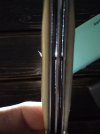- Joined
- Oct 17, 2009
- Messages
- 1,076
I'm not sure if this is the right place to ask, but I'm sure someone here can help.
So Im putting together my second slipjoint (Trapper pattern) and the gaps between the spring and liners are so large I can see the pins. How is this avoided?
The liners were perfectly flat, and I can't figure out what I'm doing to make this so bad. This is the second time I've had this problem, so I'm missing something in the process.
So Im putting together my second slipjoint (Trapper pattern) and the gaps between the spring and liners are so large I can see the pins. How is this avoided?
The liners were perfectly flat, and I can't figure out what I'm doing to make this so bad. This is the second time I've had this problem, so I'm missing something in the process.

